Table of Contents
Introduction to Arunachal Pradesh Traditional Dress
Arunachal Pradesh, a vibrant state in Northeast India, is not only known for its rich cultural heritage but also for its unique and colorful traditional dresses. The traditional dress of Arunachal Pradesh reflects the diverse ethnic groups and tribes that inhabit the region. Each tribe has its distinct style of dressing, making the Arunachali ethnic wear a fascinating subject to explore.
For men, the traditional dress of Arunachal Pradesh male typically consists of a lungi-like lower garment and a shirt, often accompanied by traditional headgear. These garments are usually made from the traditional fabrics of Arunachal Pradesh, showcasing intricate patterns and bright colors. On the other hand, the traditional dress of Arunachal Pradesh female is equally enchanting, comprising of elaborate skirts, blouses, and shawls, each piece symbolizing their tribe’s identity.
One of the most striking features of Arunachal Pradesh’s attire is the use of handloom textiles, which form a significant part of their cultural outfits. The handcrafted garments and traditional weaving styles seen here are not just clothing but a testament to the state’s rich artistic legacy. These clothes are not only worn in daily life but also play a crucial role in Arunachal Pradesh festival attire, where each festival brings out a plethora of vibrant and distinct clothing styles.
Additionally, the Arunachal Pradesh traditional dress images you might come across online or in books beautifully capture the essence of these garments. For those interested in owning a piece of this cultural heritage, Arunachal Pradesh dress online shopping options are available, offering a glimpse into the traditional yet dynamic fashion of the region.
| Rajasthani Traditional Dress | Traditional Dress of Gujarat |
| Kerala Traditional Dress | Odisha Traditional Dress |
| Maharashtra Traditional Dress | |
Traditional dress of Sherdukpen Tribe
The Sherdukpen tribe, residing in the beautiful state of Arunachal Pradesh in Northeast India, has a rich tradition in their clothing, reflecting their unique cultural heritage. The traditional dress of the Sherdukpen tribe is distinct for men and women, showcasing intricate designs and vibrant colors.
Traditional Dress of Sherdukpen Men
The traditional dress of Sherdukpen men is a reflection of their strong cultural identity. The main garment is a knee-length robe, often in deep shades like maroon or blue. This robe, known locally as a “chuba,” is typically made from thick, handwoven wool, making it both durable and suitable for the cool mountainous climate. Around the waist, they wear a colorful cummerbund, which adds a splash of contrast to the attire.
Accompanying the chuba is a jacket, often embellished with intricate patterns. These patterns are not just decorative but also hold cultural significance, representing various aspects of their tribal mythology and heritage. A distinctive hat, made of yak hair, is an essential part of the attire. It’s unique in shape and is often adorned with feathers and beads, symbolizing status and personal achievements.
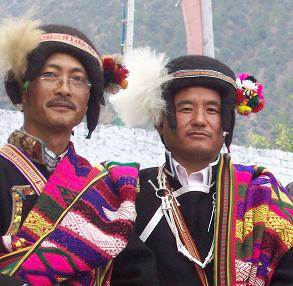
Traditional Dress of Sherdukpen Women
The traditional dress of Sherdukpen women is both elegant and symbolic. It consists of a long dress, reaching down to the ankles, paired with a jacket. The dress, known as “shingka,” is made from finely woven fabric, showcasing the tribe’s handloom textiles skills. The colors are usually bright, with reds, greens, and blues being predominant.
Women also wear a waistcoat over the dress, elaborately decorated with beads and local motifs. These motifs are not just for ornamentation but also narrate stories of the tribe’s ancestry and beliefs. The headgear for women is quite elaborate, often decorated with beads, feathers, and sometimes, silver ornaments. This headgear is not just a fashion statement but a marker of marital status and social standing within the tribe.
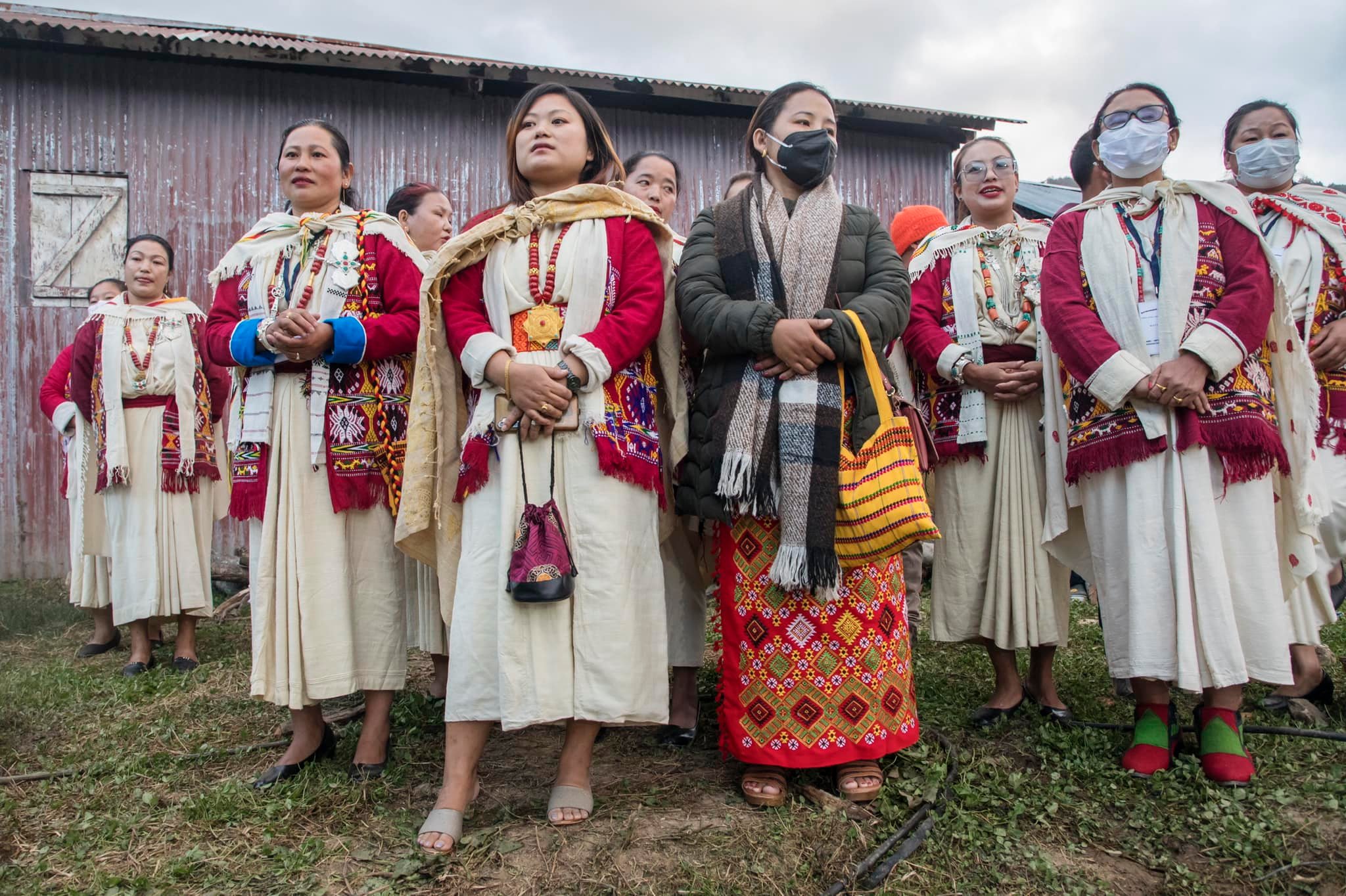
Accessories and Footwear
Both men and women accessorize their traditional attire with handmade jewelry, including necklaces and bracelets made from beads, bones, and metals. The footwear is generally simple, sturdy, and practical, suited to the hilly terrain of Arunachal Pradesh.
| Culture of Rajasthan | Culture of Kerala |
| Culture of Manipur | Culture of Assam |
| Culture of Andaman and Nicobar Islands | |
The traditional dress of the Tangsa tribe, a prominent group in Arunachal Pradesh, reflects the rich cultural heritage of this Northeast Indian state. These dresses are a vibrant display of the tribe’s history and traditions.

Traditional Dress of Tangsa Tribe Women
The traditional dress of Tangsa women is both colorful and symbolic. It typically consists of intricately woven skirts and blouses. The skirts, often in bright colors, are adorned with distinctive patterns that represent the tribe’s unique weaving styles. These skirts are usually paired with a blouse, which is sometimes embellished with beads and other decorative elements. The ensemble reflects the indigenous clothing of Arunachal Pradesh and showcases the traditional fabrics of Arunachal Pradesh.
Jewelry also plays a significant role in the traditional attire of Tangsa women. Necklaces and earrings, often made from beads and metals, complement their colorful attire. During festivals and special occasions, these traditional dresses are worn with pride, embodying the Arunachal Pradesh festival attire.
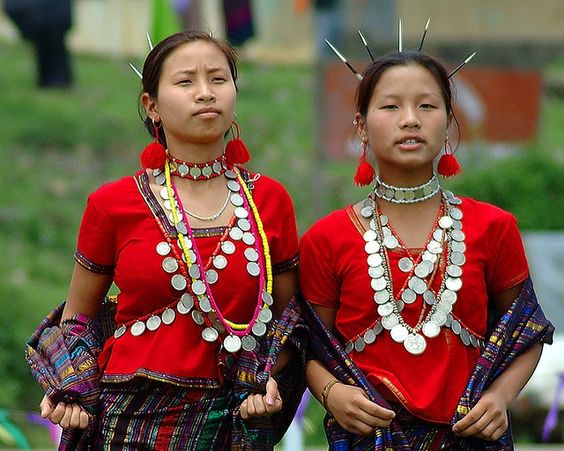
Traditional Dress of Tangsa Tribe Men
For men, the traditional dress of the Tangsa tribe is both functional and symbolic. It typically includes a loin cloth and a jacket. The loin cloth, made from handloom textiles of Arunachal Pradesh, is usually in darker hues and may feature stripes or simple patterns. The jacket, often in a solid color, is sometimes adorned with tribal motifs, reflecting the ethnic dress patterns of Northeast India.
In addition to their clothing, Tangsa men often wear traditional headgear during cultural events. These headgears are usually made from natural materials like bamboo and feathers, showcasing the tribe’s connection with nature and their skill in handcrafted garments.
The traditional dress of the Tangsa tribe is a vivid representation of the Arunachal tribal attire. It not only showcases the tribe’s skilled craftsmanship in textiles but also serves as a symbol of their cultural identity in the diverse tapestry of Arunachal Pradesh’s ethnic communities.
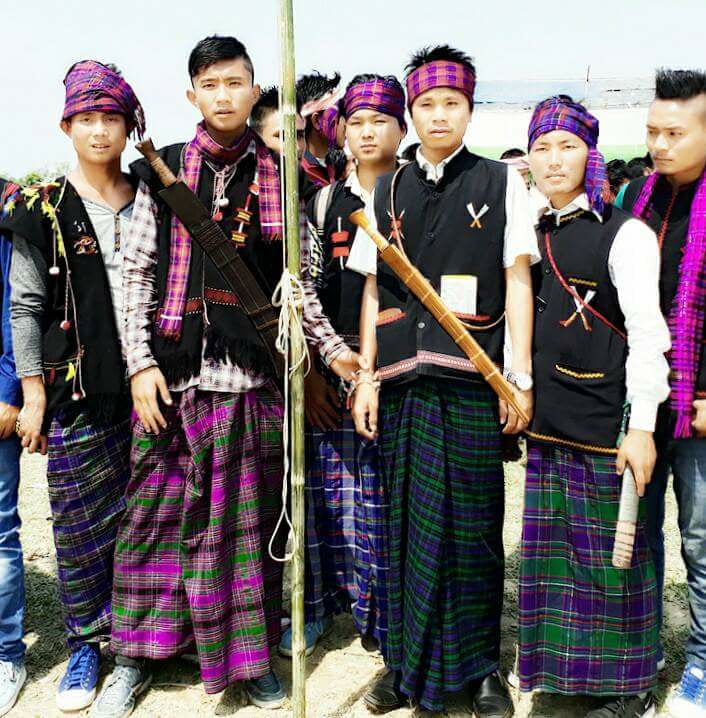
The Miji tribe, nestled in the serene landscapes of Arunachal Pradesh, boasts a rich cultural heritage, prominently reflected in their traditional dress. The attire of the Miji tribe is a vibrant expression of their ethnic identity and craftsmanship, distinguished by unique designs and fabrics.
Traditional Dress of Miji Tribe Women
The traditional dress of Arunachal Pradesh female members of the Miji tribe is both elegant and distinctive. Women typically wear a garment known as ‘Aking’, a beautifully woven skirt that wraps around the waist. The Aking is characterized by its bright colors and intricate patterns, embodying the traditional weaving styles of Arunachal Pradesh. Paired with the Aking is a blouse that complements the skirt’s vibrant hues.
Ornamentation plays a crucial role in the Miji women’s attire. They often adorn themselves with traditional jewelry made from beads and other natural materials, enhancing the richness of their ensemble. This attire is not just a daily wear but also an integral part of Arunachal Pradesh festival attire, showcasing the tribe’s cultural richness.
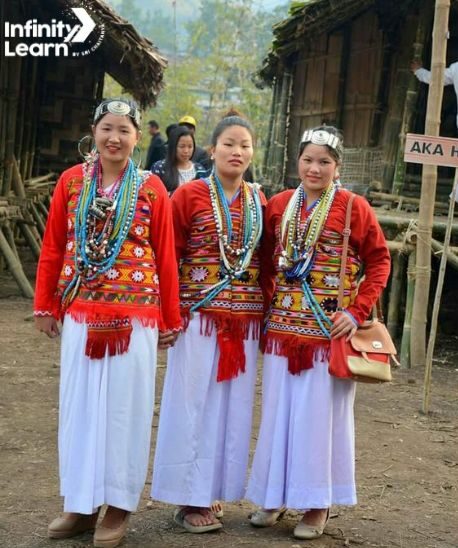
Traditional Dress of Miji Tribe Men
The traditional dress of Arunachal Pradesh male members in the Miji tribe is distinct and functional. Men wear a long, sleeveless cloak known as ‘Erong’, which hangs from the shoulders. The Erong is typically made from handwoven fabric, showcasing the handloom textiles of Arunachal Pradesh. It is often in darker shades, contrasting the women’s brighter attire.
Accompanying the Erong is a loin cloth, another essential component of the traditional male attire. The simplicity of the loin cloth balances the Erong’s heavy draping, creating an attire that is both practical and symbolic of the Miji tribe’s traditions.
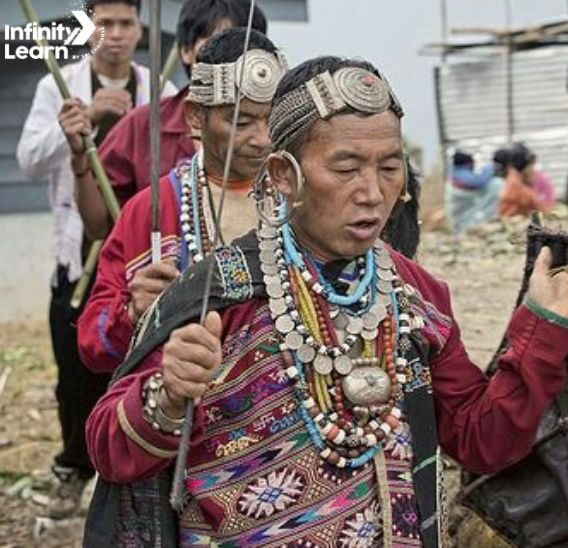
Traditional dress of Adi Tribe
The Adi tribe, one of the many vibrant tribes of Arunachal Pradesh, has a rich tradition expressed vividly through its traditional dress. The attire of the Adi tribe is a wonderful representation of the Arunachal tribal attire and plays a significant role in the cultural outfits of Arunachal Pradesh.
Traditional Dress of Adi Tribe for Women
The traditional dress of Adi women is both elegant and symbolic. It usually consists of a piece of cloth called ‘Gale’, which is wrapped around the body. This garment is often richly decorated with intricate designs, reflecting the traditional weaving styles of Arunachal Pradesh. The colors and patterns are not just for aesthetics; they often hold cultural significance, representing various aspects of Adi life and history.
Adi women also adorn themselves with traditional jewelry, made primarily from beads and metals. This jewelry is not only an accessory but also a marker of one’s social status within the tribe. The entire ensemble is a beautiful representation of the Indigenous clothing of Arunachal Pradesh.
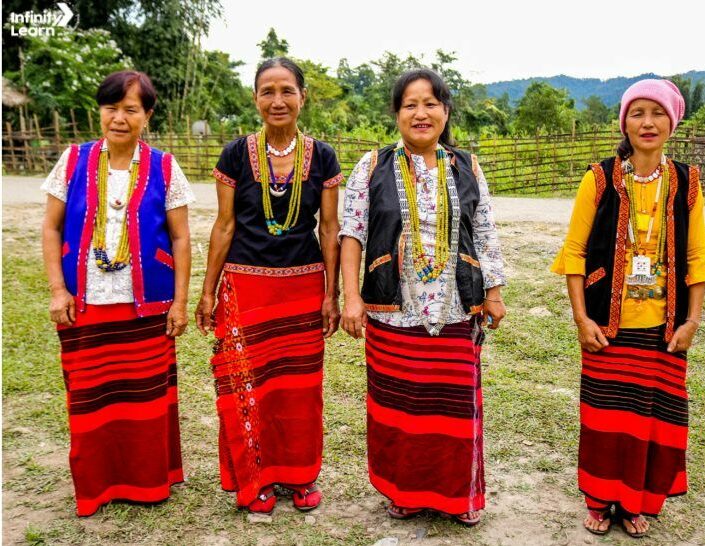
Traditional Dress of Adi Tribe for Men
The traditional attire for Adi men is equally distinctive. It typically includes a loin cloth known as ‘Minyong’ or ‘Donggin’. This piece of clothing is usually made from handwoven fabric, showcasing the tribe’s skill in handloom textiles of Arunachal Pradesh. The fabric is often decorated with local motifs, adding a unique cultural touch.
In addition to this, men wear a jacket-like garment called ‘Erong’, which is also decorated with patterns and sometimes adorned with fur. The combination of these garments not only serves as clothing but also as a symbol of masculinity and tribal identity, truly reflecting the traditional costumes of Arunachal tribes.
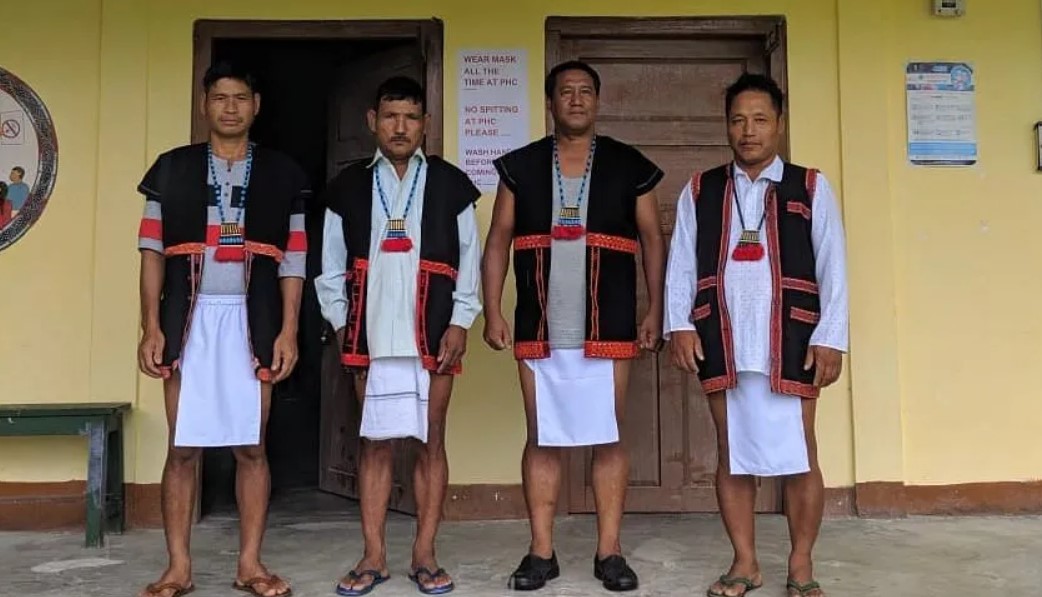
Traditional dress of Monpas
The Monpa tribe, hailing from Arunachal Pradesh, has a rich cultural heritage, vividly reflected in their traditional attire. This attire is not just clothing; it’s a symbol of their identity and tradition.
Monpa Traditional Dress for Men
he traditional dress of Monpa men is unique and practical. Known as the ‘Goncha’, it’s a long-sleeved robe tied around the waist with a sash. This attire, often made from thick woolen fabric, is suited to the cool climate of Arunachal Pradesh. The simplicity of the Goncha makes it elegant, and it’s often paired with trousers and a warm jacket, necessary for the region’s cold weather. The colors are usually earthy, reflecting their close connection to nature.

Monpa Traditional Dress for Women
Women of the Monpa tribe wear a garment called ‘Chuba’, a beautiful, long dress accompanied by a jacket. The Chuba is often richly colored, adorned with intricate patterns that signify the tribe’s artistry. Unlike the men’s Goncha, women’s dresses are usually brighter and more decorative. They accessorize this dress with traditional jewelry and a headdress, adding to the dress’s visual appeal.
Both men’s and women’s traditional dresses represent the Arunachal tribal attire and are a significant part of the Northeast India cultural dress. While these traditional garments are primarily worn during festivals and important occasions, they symbolize the rich cultural tapestry of the Monpa people. The use of local Traditional fabrics of Arunachal Pradesh and the Handloom textiles of Arunachal Pradesh in crafting these dresses shows the community’s skill in weaving and garment making.
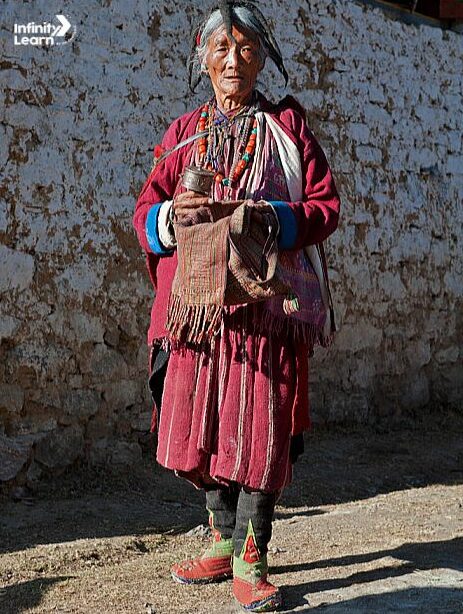
Traditional dress of Tribe of Lower Kamla Valley
The traditional dress of the tribes of the Lower Kamla Valley in Arunachal Pradesh reflects the rich cultural heritage and unique lifestyle of this region. Let’s explore the distinct traditional attire for both men and women of this tribe.
Traditional Dress of Lower Kamla Valley Men
The traditional dress of Arunachal Pradesh male members in the Lower Kamla Valley predominantly consists of a loin cloth known as ‘Wanch’. This simple yet significant attire is usually made from local materials, showcasing the traditional weaving styles of Arunachal Pradesh. Men often complement their look with accessories like headgears adorned with feathers and beads, which are significant to their tribal identity. These accessories are not just decorative but also hold cultural significance, symbolizing various aspects of their lifestyle and beliefs.
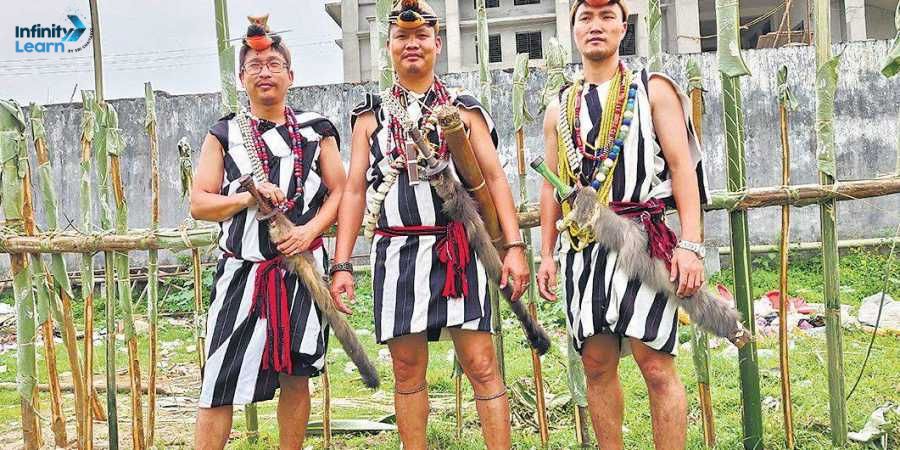
Traditional Dress of Lower Kamla Valley Women
The traditional dress of Arunachal Pradesh female tribe members is a beautiful combination of elegance and cultural expression. Women typically wear a piece of cloth wrapped around the waist, extending to the ankles, known as ‘Musha’. This is often paired with a blouse or bodice. The fabrics used are generally handwoven, reflecting the handloom textiles of Arunachal Pradesh and the skillful artistry of the women in the tribe. The colors and patterns of the Musha vary, often indicating the marital status or age of the woman.
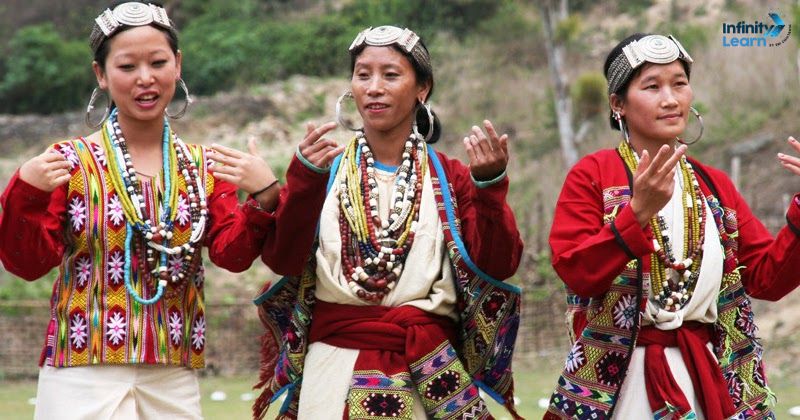
How to Wear Arunachal Pradesh Traditional Dress
Arunachal Pradesh, known for its rich culture and heritage, has a distinctive traditional dress that is a symbol of the state’s ethnic diversity. The traditional attire varies between men and women, each reflecting the unique tribal fashion of this northeastern Indian state.
For Women: Arunachal Pradesh Traditional Dress Female
Women in Arunachal Pradesh wear a variety of traditional dresses, with each tribe showcasing its own unique style. A common attire is a full-length dress, often brightly colored and adorned with intricate patterns. Here’s how to wear it:
- Choosing the Dress: Select a traditional dress that represents a specific tribe, such as the Apatani or Galo. Look for handloom textiles of Arunachal Pradesh which are known for their quality and vibrancy.
- Wearing the Dress: The dress is usually wrapped around the body and secured at the waist, draping elegantly. Some dresses come with a fitted bodice and a flared skirt.
- Accessorizing: Complete the look with traditional jewelry like necklaces and earrings made from beads and metals. Women often wear headgear adorned with feathers and beads.
- Traditional Shawls: Add a shawl, known for traditional weaving styles of Arunachal Pradesh, for an authentic look. These shawls often have symbolic patterns and motifs.
For Men: Arunachal Pradesh Traditional Dress Male
Men’s traditional attire is equally distinctive, featuring a simpler yet elegant style:
- Selecting the Attire: Men typically wear a sleeveless shirt and a lungi-like lower garment. These are often in natural colors, with tribal motifs.
- Putting on the Garments: The shirt is usually straightforward to wear, while the lower garment is wrapped around the waist and secured.
- Adding Accessories: Men also accessorize with traditional hats or headgear, often made of cane and adorned with feathers.
- Completing the Look: Traditional boots made from local materials can complete the outfit, adding to the authenticity of the attire.
Traditional Fabrics and Patterns of Arunachal Pradesh
The traditional fabrics and patterns of Arunachal Pradesh are a vivid representation of the state’s rich cultural heritage. Nestled in the Northeast of India, Arunachal Pradesh is home to various tribes, each contributing uniquely to the textile tapestry of the region.
Weaving: A Cultural Pillar
Weaving is not just a craft but a cultural pillar in Arunachal Pradesh. The state’s traditional fabrics are predominantly handwoven, a skill passed down through generations, especially among women. Each tribe has its distinct weaving patterns, color schemes, and motifs, making the fabrics not just garments but a form of storytelling and preservation of heritage.
Motifs and Symbolism
The motifs in Arunachali textiles often draw inspiration from nature and tribal mythology. Common motifs include geometric patterns, animal figures, and nature-inspired designs. These motifs are more than decorative elements; they carry deep symbolic meanings, representing various aspects of tribal life, beliefs, and the environment.
Diverse Textile Varieties
The diversity in the state’s textiles is remarkable. The Monpa tribe is known for their intricate woven jackets and shawls, while the Apatani tribe produces exquisite handloom fabrics with distinctive designs. Similarly, the Galo tribe is famous for their vibrant ‘Gale’, a traditional wraparound skirt. The Adi tribe showcases skill in their ‘Ege’, a type of jacket, and ‘Minyong’, their traditional skirt.
Colors and Materials
The colors used in Arunachali fabrics are often bright and symbolic. Reds, yellows, blues, and greens are predominant, each color having its significance, often related to nature or spiritual beliefs. The primary materials used are cotton and wool, with an increasing incorporation of synthetic yarns in contemporary times.
Traditional Handlooms
The traditional handlooms of Arunachal Pradesh are a crucial aspect of their fabric-making process. These looms, often rudimentary yet highly effective, are used to create intricate patterns and designs that are unique to the state. The handloom textiles of Arunachal Pradesh are not just clothing; they are a testament to the artisanal skills and cultural ethos of the region.
Preservation and Evolution
In recent years, there has been a growing effort to preserve and promote the traditional weaving styles of Arunachal Pradesh. The state’s government, along with various cultural organizations, has been working towards reviving old patterns and introducing the art of weaving to the younger generation.
FAQs on Traditional Dress of Arunachal Pradesh
What is the mother tongue of Arunachal Pradesh?
Arunachal Pradesh is a linguistically diverse state with no single mother tongue. It is home to over 50 languages, including Nyishi, Adi, Apatani, and Monpa.
What is the name of traditional saree in AP?
In Andhra Pradesh (AP), the traditional saree is often referred to as Kanduva or Pochampally, known for its unique weaving style and patterns.
What is Mishmi traditional dress of Arunachal Pradesh?
The Mishmi traditional dress of Arunachal Pradesh typically includes intricately woven tunics and skirts for women, and a distinct jacket and pant combination for men.
What is the dress festival of Arunachal Pradesh?
The dress festival of Arunachal Pradesh is Solung of the Adi tribe, where people don traditional attire to celebrate. It's a vibrant showcase of Arunachal Pradesh's ethnic wear.
What is our Andhra Pradesh traditional dress?
The traditional dress of Andhra Pradesh for women is the saree, particularly the Pochampally and Gadwal sarees, while men often wear dhoti and kurta.
What is traditional dress of Arunachal Pradesh called?
The traditional dress of Arunachal Pradesh varies by tribe, but commonly, women wear a wraparound skirt called Gale, and men wear a loincloth known as Suru.










